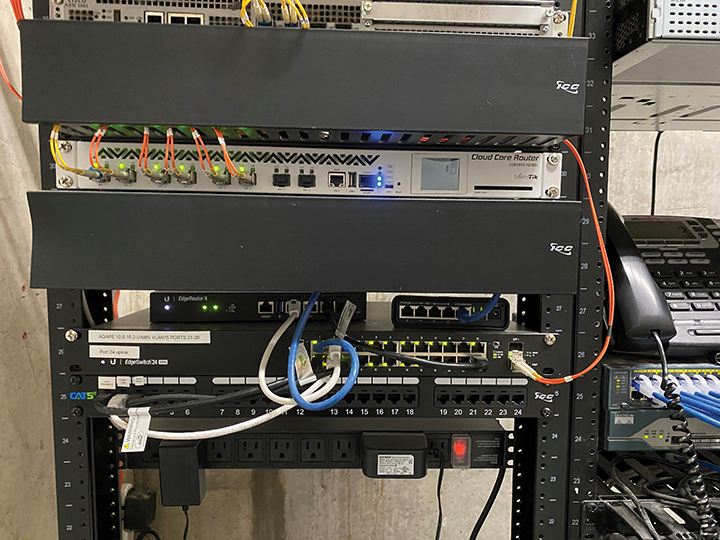Angelus Plaza is the largest affordable community for older adults in Los Angeles. It’s operated by the Retirement Housing Foundation (RHF), one of the nation’s largest nonprofit providers of subsidized housing and services for older adults, persons with disabilities and low-income families. Housing a diverse community of approximately 1,400 residents, the community offers 1,093 one-bedroom apartments in five high-rise towers.
Angelus Plaza has served downtown Los Angeles since 1980 and is situated in the Bunker Hill district, near Angels Flight Railway, Grand Central Market, California Plaza, the Walt Disney Concert Hall, The Music Center and The Broad museum.
Its six-story senior center provides residents access to health services, meals, recreation, social engagement and lifelong learning. It also houses meeting rooms, a library, classrooms, activity rooms, a 250-seat auditorium and offices available for use by residents and nonprofit community organizations.
The facility offers many on-site services, including the Tom Bradley Center for Health Care, a congregate meal nutrition program, a pharmacy, a beauty salon and a mini market. Angelus Plaza is also a Los Angeles Unified School District continuation high-school site.
As Angelus Plaza’s residents weathered the storm of the COVID-19 pandemic, broadband helped them engage with their families remotely. Commercial Connectivity Services (CCS), an ISP reseller, supplied the community fiber-based broadband.
Jeff Skolnick, president of CCS, says by offering high-speed internet, it can help seniors use technology. In addition, CCS installed video cameras in each unit.
“We are giving residents the ability to speak with their families via FaceTime and/or Zoom,” he says. “They would not be able to do that without our fiber-based service. It has turned into not only a money-making opportunity but also a good deed.”

Focus on Fiber-Based Broadband
Prior to CCS, the only service Angelus Plaza could get was low-speed DSL, which can’t keep up with bandwidth-hungry Zoom and FaceTime sessions.
“A colleague of ours who works with Angelus Plaza found out DSL was the only option,” Skolnick says. “A lot of the residents were complaining about their service, and we grabbed that opportunity because our sweet spot is to find a building that needs our service.”
With a fiber network in place, CCS offers three tiers: 10/10, 25/25 and 50/50 Mbps. The 10 Mbps tier is the most popular – two-thirds of Angelus Plaza’s residents subscribe to it. “It’s not really a sales push when someone calls us because it is not worth it to convince them they need a higher speed when they really don’t,” Skolnick says.
A key part of the broadband service is CCS’s ability to work with local LECs to provide fiber-based broadband to residents. Wholesale fiber can take 60 to 90 days to procure from a local service provider such as AT&T.
“Being in the channel, we have access to local exchange carrier fiber facilities,” Skolnick says. “We can purchase the fiber circuit and put it into the building.”
Created to serve as an in-house ISP for a landlord, CCS offers services in the California communities of West Covina, Canoga Park, Calabasas and Studio City. It is currently vetting opportunities in several other U.S. states.
CCS becomes an ISP for building tenants in residential and commercial properties. It negotiates with landlords to serve tenants with fiber-based broadband service at a 30 to 70 percent discount from the price they would pay for service from an incumbent telco or cable operator.
“It’s a win for the tenants because they get fiber-based internet at a reduced cost. Because it’s already in the building there’s no downtime or waiting for service,” Skolnick says.
He adds that landlords benefit through additional revenue and retention and recruitment.
“Being able to tell a prospective tenant there is fiber-based internet in a building that’s cheaper than other services helps lease the building and retain residents because they are not going to go somewhere else if they have that service,” Skolnick says.
CCS’s partnership with Aditum, a hosted internet management service platform provider, enables it to get customers up and running. Aditum’s platform is for any multitenant environment in which a landlord wants to resell internet service to tenants (both commercial and residential).
The company’s zero-touch system auto-configures the customer router. WAN, LAN and wireless are configured and tailored from customer records. Everything is administered from a property owner’s custom cloud portal.
“We work with partners to enable deployment of bandwidth in commercial and residential MDU properties,” says Brian Higgins, CEO of Aditum.
Property of the Month Highlights
~ Angelus Plaza in Los Angeles ~
- Serves 1,400 residents with fiber-based broadband
- Offers 10/10, 25/25 and 50/50 Mbps internet tiers
- Wi-Fi, streaming TV service
- Units equipped with video cameras
- Fiber network serves residents and adjacent hospital, pharmacy and senior center
A Unique Build
CCS is used to building out broadband to MDUs, but Angelus Plaza had various unique aspects. For one, CCS had to overcome the challenge of bringing in one fiber circuit to deliver service to the property’s four towers.
CCS serves not only residential consumers but also the hospital, the computer lab, the pharmacy, and administration building locations. Higgins says Aditum continues to see service provider partners serving multiuse buildings.
“A lot of our customers deploy a common IP backbone through the property,” he says. “Whether it be the fire alarm, cameras, or a backbone for a DAS system – the partner becomes the provider for everything in that building.”
CCS continues to find that each property it serves has its own set of requirements that can’t be seen until the planning stage.
“When I am talking to a potential customer, they always want to know what it will cost, but I always tell them it’s hard to say because every building is like a brand-new business,” Skolnick says.
CCS distributes fiber signals by locating their intermediate distribution frame (IDF) on each odd floor in a closet of the 17-floor tower.
It then runs the wire from the closet and directly into a unit via a standard pathway. If the unit is on an even-numbered floor, CCS goes down through the wiring closet to the IDF. Finally, it locates the Aditum zero-touch router inside the closet in the primary bedroom. “Given the size of the units, the router can serve the entire apartment itself,” Skolnick says.
Vital Stats
Property description: The RHF Angelus Plaza is an MDU located in downtown Los Angeles.
Tenant demographic: Retired, low-income seniors
Type of building: High-rise
Style of building: Four 17-story towers
New or retrofit: Retrofit
Date services started to be delivered: March 2018
Services offered: Wi-Fi and TV streaming
Provider choice: AT&Toffers DSL services and NextLevel Internet offers business services in the community.
Technical Support: In-house
Services
Do additional service providers operate separate broadband networks on the same property? Yes
Can tenants choose among multiple service providers? Yes
Is the point of contact for tenant technical support the property manager, the service provider or a third party? CCS, which serves as the ISP, provides technical support.
Business
Which parts of the network are owned by the service provider, and which parts are owned by the property owner? The service provider owns the network.
Is there a marketing agreement with the property owner? Yes

Technology
Fiber to the Intermediate Distribution Frame: 1/1 Gbps fiber
Technology/medium used to deliver signals to each unit: Category-6 Ethernet
Methods of running cables between buildings: Aditum’s Zero-Touch router device enables property owners/managers to serve as multitenant internet providers. This creates the opportunity for them to monetize tenants’ internet connections. Fiber is distributed from the router device to the main distribution frame (MDF) of each tower. Fiber is distributed from the MDF of each tower to a managed data switch at every other floor.
Vendors/products
- Ubiquiti UNMS managed network
- Aditum
Lessons Learned
What was the biggest challenge? Initially it was ameliorating communication difficulties with residents and fostering trust.
What was the biggest success? During the original launch of service, we hosted weekly table demos, alternating between the lobbies of each tower. The demos sales day typically resulted in several new sign-ups and multiple follow-up sales appointments.
What should other owners consider before they get started on a similar deployment? Understand the service you provide and know what the potential revenue could be.














